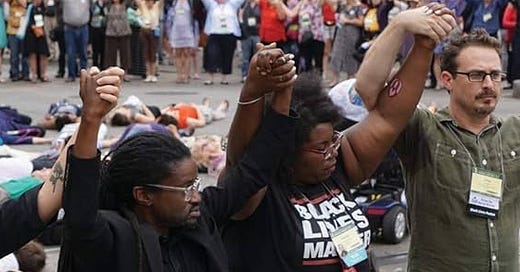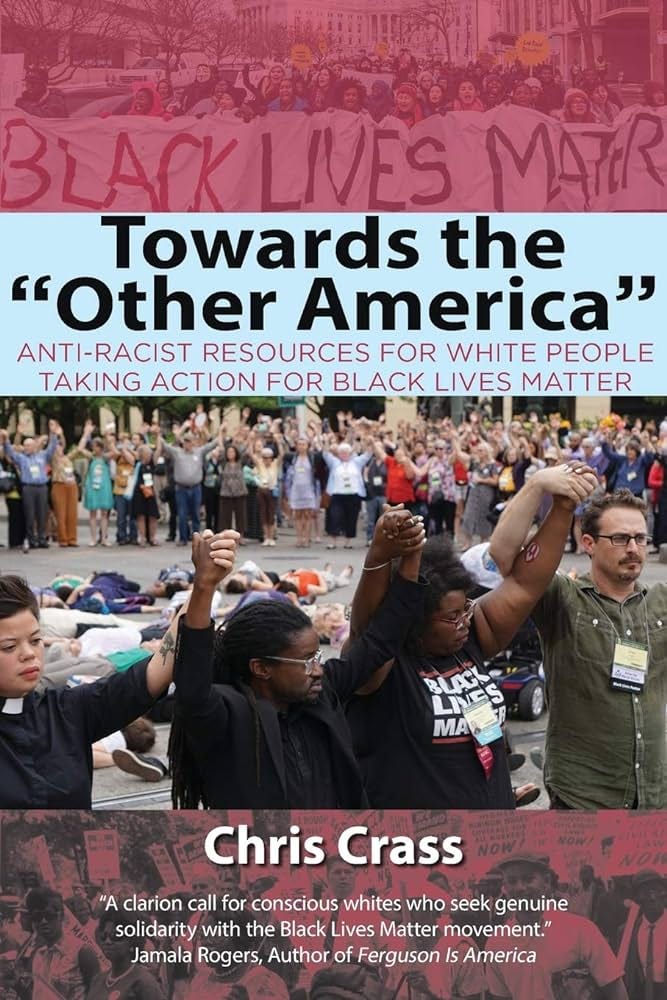Anti-Black Racism, The Minstrel Show, and the Making of Whiteness
The minstrel shows of the 1800s were used to teach European immigrants to see Black people as their inferiors and to submit to capitalist exploitation.
This month's issue features a guest contribution from a good friend and inspiration of mine, Chris Crass. In 2015, Chris published a book called, Towards the "Other America": Anti-Racist Resources for White People Taking Action for Black Lives Matter (Above is an image of Chris and fellow activists from the book cover). It is a collection of his essays, one of which I asked Chris if I could share here. The piece below is particularly powerful to me because it clearly illustrates how blackface minstrel shows of the 1800s were strategically used to socialize European immigrants to replace their traditional cultures and radical politics with anti-black racism and submission to their own exploitation.
For all of us who want to move white people into anti-racist consciousness and actions, we must remember the dual role that anti-Black racism plays in disciplining white people to capitalist exploitation. Anti-Black racism was most famously fused into popular culture and ideology through the Blackface minstrel shows. The minstrel show became the national art form by the mid-1800s, and taught millions of Europeans, many of them recent immigrants, what it meant to be white. In fact, the term “Jim Crow,” used to describe the segregated apartheid South after Reconstruction, comes from a highly popular character, in black face, in the early days of the minstrel show.
On the one hand, the minstrel shows were intended to discipline immigrant Europeans, from a wide range of agriculture-based cultures, into the White Protestant work ethic that barons of industry wanted infused in their workforce. Industrial capitalism wanted a workforce that internalized the values of a self-sacrificing work ethic and a culture of individualism. Industrial capitalism devastated European-American workers’ sense of community, and sense of self as bosses looked for ever more ways to exploit workers’ labor to make profits. This was a time of expanding slums, growing alcoholism, and, to fight back, workers beginning to form unions.
On the surface, the minstrel show is about Black culture. Black culture was portrayed as promoting laziness (lacking a Protestant work ethic), with Black people exhibiting the playfulness of children and the lustfulness of beasts (totally lacking the values of self-sacrifice and self-mastery). Below the surface, the minstrel show was teaching European-Americans what it meant to be white in a capitalist economy. Being white meant you were supposed to be a self-made man (or married to one), exercise self-control, work hard, not rock the boat, and pull your weight (i.e., make bosses rich, not complain about wages or work conditions). Being a white man meant protecting white women from the "uncontrollable lust" of the Black man.
The minstrel show taught European-Americans that to be white meant despising the supposedly “incompetent” and “lazy” culture of Black people that makes them forever dependent on white people to take care of them. In the minstrel show, white people are civilized and Black people are borderline animals who either need to be taken care of for their own good, or are dangerous beasts out to get white women.
The underlying themes of the minstrel show are all around us today. Everyone must pull themselves up by their own bootstraps and if you aren’t economically prosperous, well then, you have no one to blame but yourself. White people are told they are superior to all others, and so if you are white and not wealthy, then it must be because those dependent, lazy, childlike Blacks and other people of color are pulling you and the economy down. Or, Blacks and other people of color are cheats and criminals, both common minstrel show characters, who are stealing from white America directly or have pulled a con and are stealing from white America collectively—through welfare, food stamps, or by taking unionized public sector jobs or spots in college away from more qualified whites through Affirmative Action. None of this is true, of course, but white supremacy isn’t about truth. White supremacy in the United States is primarily about organizing the economy and the political system to serve the interests of elites at the expense of the vast majority of people. White supremacy is a divide-and-rule strategy to maintain structural inequality and the logic and culture of supremacy systems that normalize and rationalize inequality.
James Baldwin famously said to white America, “If I am not who you think I am, you are not who you think you are.” Our responsibility as white anti-racists who want to dismantle white supremacy, who want to win and build a world where Black lives matter, who want economic justice for all, our responsibility is to understand that white racist rage and white resistance to Black equality is rooted in white anger and pain for not achieving the American Dream. Working class and poor white people, and even more and more white middle class people, are experiencing the long-term effects of stagnant wages while CEOs make millions and TV shows make it seem like everyone is bringing in $150,000 a year (even middle class Blacks).
With decades of right-wing-led cuts to public institutions like schools, libraries, and parks, alongside massive spending to expand policing and the prison system, many white people are told that society is both out of control and that the "pathologically dependent" and "criminal" culture of Black and Brown America is to blame. White people have been sold a pack of lies about working hard and achieving economic prosperity. When that prosperity doesn’t happen, it isn’t the fault of multinational corporations that moved decent paying union jobs out of the U.S. to exploit third world workers, and it isn’t the fault of the Republican and Democratic Parties that have passed legislation funneling money to corporate power; it’s because of Brown-skinned immigrants and dark-skinned welfare families.
Recently, I was at an immigrant rights demonstration in Nashville, Tennessee. President Obama was visiting an immigrant social service provider and there were dueling protests. There were those, like myself, who wanted Obama to pass far-reaching immigration reform based in economic justice for all and multiracial democracy rather than criminalization. Then there were the Tea Party anti-immigrant protesters calling for mass deportation and further militarization of the Border. I was standing next to a working class white mother, holding her young child in one hand and an anti-immigrant sign in the other. She told me she was protesting Obama because he was letting “illegal” immigrants stay in the country and get food stamps, while she herself had been denied food stamps to take care of her kids. Most of the white Tea Party people there were middle class, and I felt quite confident that most or all of them had been fighting to have food stamps cut. While the majority demographic utilizing welfare and food stamps is white people, the rhetoric used is that it’s Black and Brown women who are taking advantage of the system and eating lobster, while hard-working stiffs can barely afford to put food on their families’ plates. I was holding my son at that rally as well. In the mother’s words, I felt the pain and tragedy of racism in white lives, as well as its ability to marshal violent political racist action. I looked at our children, both being raised white in a culture still teaching the values performed in the minstrel show, and I felt the tremendous need to save our kids from the death culture of white supremacy.
For white anti-racists, our task is to demand that Black lives matter and learn to deeply speak to, bear witness to, and listen to the pain underneath white racist rage and resentment. We must learn how to listen to white racial pain and attach it to the real enemy of structural inequality while naming racism as the violent poison that it is.
Our task is to simultaneously work in solidarity with Black leadership and people of color building this movement, and to develop the leadership of white anti-racists, particularly working class and poor people’s leadership. Our vision is both a world where Black lives matter and a society based on multiracial democracy and economic justice for all, where the hearts and minds of white people have been freed from the death culture of white supremacy and anti-black racism.
As people racialized as white in a white supremacist society, we must forge new identities rooted in liberation values, and committed to challenging structural oppression. This is the process of unlearning the lies of capitalist individualism and racist fear. This is the process of embracing our shared humanity, creating a just world and building beloved community. When we break white silence that gives consent to racism, we must speak fluently and courageously about a life-affirming culture and society that also uproots capitalism and builds economic justice for all.







